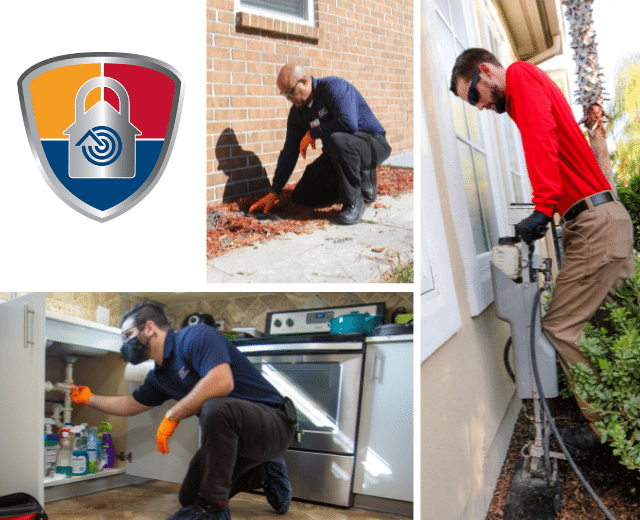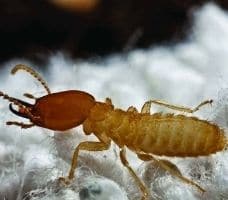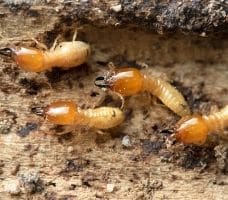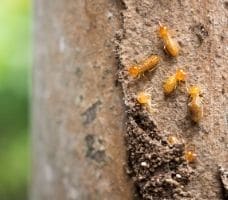WE GET RID OF TERMITES AND KEEP THEM FROM COMING BACK.
It’s your home: Count on Turner for comprehensive termite extermination

OUR SAFE, EFFECTIVE TREATMENT PUTS AN END TO SWARMING TERMITES.
Florida is home to several kinds of termites that can cause damage, including subterranean, drywood and dampwood termites. Some termites, known as swarmers, develop wings in order to fly to sites where they can establish new colonies. Because the various species swarm at different times, these pests can be seen almost any time of year.
If you’ve seen signs of swarming termites, here’s what you need to know.
Here’s what else you can expect from your Turner Pest Control swarming termite service:
FREE ESTIMATES: There’s never any charge or any obligation for quotes on our comprehensive termite treatment plans, and you can request your estimate online.
A THOROUGH INSPECTION: Our expert technicians know just where termites hide. We inspect your home’s interior and exterior for signs of termite damage and termite activity.
A CUSTOMIZED PLAN: Based on the results of our inspection, we create a termite extermination plan that meets your specific needs and pest pressures.
EXPERT TERMITE TREATMENT: Our up-to-the-minute training and technology ensures that your termite control service is the safest, most effective, and longest-lasting treatment available.
SWARMING TERMITES
Termite swarming habits
Our area’s humid climate offers the perfect environment for swarming termites. These are a few of the common types of drywood and subterranean termites and when you’re likely to see them in Florida.
Southeastern drywood termites are usually seen from May to November between dusk and dawn. This is the most widely distributed termite in the eastern U.S., particularly in the coastal regions of the southeast. Unlike subterranean termites, drywood termites live entirely within the wood they infest, even getting their water from the wood’s fiber.
Over a period of a few weeks each year, some of the drywood termites in a colony molt into winged swarmers and leave the colony to seek sites for new colonies. You may see them attracted to lights around the outside of your house.
These termites will infest softwoods and solid hardwoods, including types of lumbers commonly used in structural framing. Even structures that are only a few years old may become infested. Drywood termites leave behind “frass” – or debris pellets of termite fecal matter that look like coffee grounds or pepper in most cases.
SIGNS OF SWARMING TERMITES
Since they’re sometimes attracted to light, you may see swarmers outdoors near windowsills, light fixtures and doors. The termites themselves may be visible, or you’ll see the wings they’ve discarded before they moved into the location of the new colony. Because drywood termites stay hidden within wood, the wings may be the only sign of them.
A single type of pest control method won’t be effective on all kinds of termites, so it’s important to consult with a pest control professional to verify the kind of termite you may have and develop the right treatment plan. If you haven’t seen signs of termites, pretreatment is the best way to avoid an infestation of these common Florida pests.
Turner Pest Control offers safe and effective options for termite treatment, including the Termidor HP High Precision Injection System, an advanced method for treating your home with very little disruption to your landscaping, patios and pool decks. Contact us to learn more about our comprehensive termite treatment programs and all of our pest control services.
FORMOSAN SUBTERRANEAN TERMITES
Appear in late spring and swarm at night. This non-native termite was discovered hundreds of years ago, but wasn’t seen in the U.S. until the 1960s when it was found in South Carolina, Louisiana and Texas. Today, most southern states are home to Formosan termites.
EASTERN SUBTERRANEAN TERMITES
Are seen in fall and winter in daylight hours. There are three different species of Eastern subterranean termites in Florida and each swarms at different times between early December and late May. Two of the species swarm after daytime rains and the third swarms at night.
WEST INDIAN DRYWOOD TERMITES
Are often found between April and July. This is a non-native termite and the most widespread drywood termite throughout tropical regions. In the U.S., they are common in Florida and some parts of the southeastern coastal region. Their habits are similar to Southeastern drywood termite described above.
FREQUENTLY ASKED QUESTIONS
Don’t see your question answered? Get in touch today!
What are swarming termites?
Swarming termites are insects that form large colonies and swarm to start new colonies elsewhere. They are a destructive species of termite and can cause considerable damage to structures if left unchecked and untreated.
What signs indicate termite swarming?
The most common signs of swarming termites are generally piles of winged adults around windows, doorways, light fixtures, or near damp areas in your home. These individuals, also known as alates, are usually more visible in the spring months and during warmer weather when the insects leave their original nest for the purpose of forming new ones. Their preference for warm weather is one reason why they are such an issue in Florida.
How can I prevent my home from becoming infested with swarming termites?
Preventing a home from becoming infested with swarming termites involves proper maintenance, such as reducing moisture levels in crawl spaces, clearing debris away from the foundation and keeping gutters clear of debris. It’s also important to have regular termite inspections of your home annually for any signs of an infestation and to have expert termite treatment when an infestation is found.
When should I contact a Turner Pest Control professional for assistance with swarming termites?
The best time to contact a Turner Pest Control professional pest control specialist is typically at the first sign of an termite infestation or when your preventive measures have not been successful in preventing an infestation.
How do I know if I have a swarming termite infestation?
To know if you have an infestation of swarming termites, inspect your home carefully for signs like piles of winged adults around your windows, doorways, and light fixtures outside your home as well as inside damp areas such as sinks, tubs, showers and basements.
Other signs include hollow-sounding wood that indicates tunneling under it or mud-like tubes that run up walls or along baseboards which create their nests within wood structures or walls made from other materials like plastic or concrete block walls.
Are there DIY treatments available for dealing with swarming termite issues?
DIY pest control treatments for dealing with swarming termite issues can include sealing off entry points into your home such as cracks in foundations and vents and using insecticides designed for controlling termites. That said, an infestation or signs of swarming termites are better handled by pest control professionals. The experts at Turner Pest Control have methods and resources available that are more effective than DIY termite treatments. At Turner Pest Control we offer three ways to treat your termite problem:
TERMIDOR HP TREATMENT: The revolutionary Termidor HP High Precision Injection System is the ultimate termite treatment.
LIQUID TREATMENT: Our expert technicians make sure your home is protected in every place where termites can enter or cause damage. We do more than meet treatment standards by treating with the maximum application allowed.
TERMITE BAIT SYSTEMS: Our termite bait systems watch over your home 24/7 and lets us easily check for activity. If we find termites during our quarterly monitoring inspections, we work with you to determine the best termite treatment strategy.
How long do treatment solutions last against swarming termites?
Treatment solutions generally last several months but may need reapplication depending on how severe the problem is as well as environmental factors such as a heavy rain season which could potentially wash away protective barriers put into place by our pest control professionals. It may take up to four weeks after the initial treatment to see a reduction in swarms, if after this time you still have concerns, contact Turner Pest Control and we’ll be happy to address your issue until you’re satisfied.
Is it possible to completely get rid of swarming termites in and around a property?
While total eradication is unlikely due to new colonies continually being formed it is possible through diligent termite prevention efforts combined with regular monitoring and termite treatment protocols to keep swarming termite populations low enough so they do not become serious threats to your home and property.



